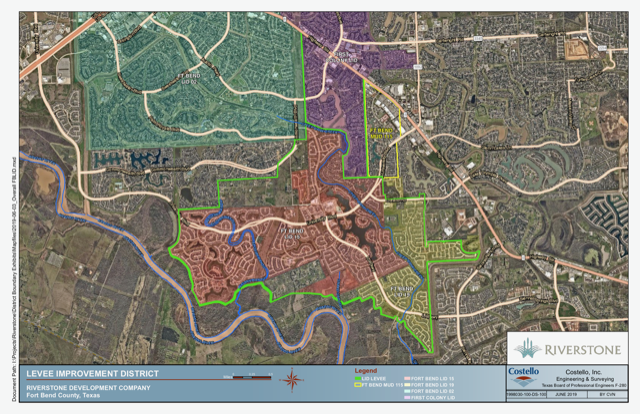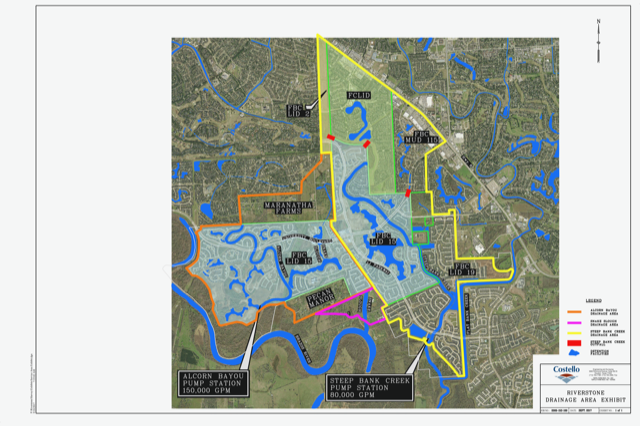Understanding water flow can be a challenging task. With the historic record-breaking rainfall event’s FBLID 19 has experienced recently, including Hurricane Harvey, the levee systems have shown their strengths and weaknesses. To date, FBLID 19’s levee has served its purpose successfully by preventing the overflow of the rising Brazos River into the district. On the other hand, the over-whelming rainfall experienced inside the levee caused concern of system’s ability to pump water back into the Brazos River quickly.
Since September 2017, efforts have been made to evaluate and increase pumping capacity to prevent the collection of rainwater on the ‘inside’ of the levee. These actions are designed to protect homes from this type of flooding. This effort began with FBLID 15 and FBLID 19’s immediate joint purchase of additional portable pumps to provide extra pumping capacity, followed by the expansion of the Steep Bank Creek pumping station. Below are explanations of terms used to understand the flow of the water within the district as well as the ability to rid the district of water in an emergency.
What is a watershed?
Answer: an area or ridges of land that separates waters flowing to different rivers, basins, or seas.
Fort Bend County, in general, has subtle topography, meaning it is generally flat and flows are typically not guided by natural hills or valleys.
Three watersheds exist the Riverstone community that flow into the Brazos River. (Map A below)
- Alcorn Bayou watershed: Area in orange
- Snake Slough watershed: Area in pink
- Steep Bank Creek watershed: Area in yellow
- FBLID 19 is located solely within the Steep Bank Creek watershed.

What is a tributary?
Answer: a creek or stream flowing into a more massive river or lake.
The three watersheds listed above are named for the tributaries they surround- Alcorn Bayou, Snake Slough, and Steep Bank Creek.
Map A above labels these tributaries that flow into the Brazos River.
The Brazos River, tributaries, retention lakes, and ditches are in blue.
What is a levee?
Answer: an embankment (a wall or bank of earth) established to prevent the overflow of a river.
Levee systems have been constructed in this area to protect naturally low-lying land from rising Brazos River waters. A levee system protects homes in FBLID 19.
The levee system protected the homeowners during the last several rain events, including Harvey, by preventing the river from flowing freely into the residential area.
Map B below shows levee boundaries in green.

What is a pump station?
Answer: facilities, including pumps and equipment, for pumping water from inside the levee back into the Brazos River.
FBLID 19 has a pump station located within the Steep Bank Creek watershed.
During the last several rain events, including Harvey, the pump station operated at full capacity pumping water back out into the river.
Steep Bank Creek pump station
Current pumping capacity—
- Built-in capacity: 4 pumps x 20,000 gpm = 80,000 gpm
- Supplemental capacity: 12 pumps of varying capacity totaling 81,000 gpm
- FBLID 15 and FBLID 19 are in the progress of expanding the pumping capacity.
- Expansion: 3 built-in pumps x 50,000 gpm = 150,000 gpm
- The project is currently in the design phase.
- Upon completion of this expansion, the pump station’s built-in capacity will be 230,000 gpm.
What additional pumps did LID 19 purchase after the Hurricane Harvey Rainfall event?
Answer: FBLID 15 and FBLID 19 jointly purchased additional portable pumps to have on hand to provide additional pumping capacity in future events. These pumps provide an additional 81,000 gpm capacity.
Residents witnessed these pumps ‘in action’ during the recent May rainfall event.
FBLID 15 and FBLID 19 are also jointly expanding the pump station at Steep Bank to add three additional pumps totaling 150,000 gpm capacity.
The FBLID 19 Board of Directors continues to work together to provide maintenance and expansion as well as an understanding for the protection of property owners. Residents are encouraged to follow Facebook and the FBLID 19 website to stay informed.



